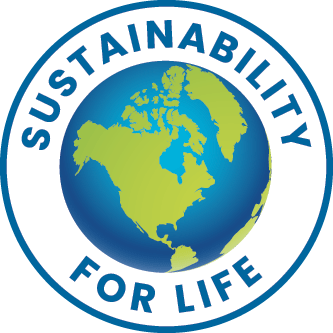Daily Habits For Sustainability

Daily Habits for Sustainability
“Each person and family can transform their lives by striving for zero carbon to atmosphere and zero waste to landfill”.
H. William Clark 2020
sustainabilityforlife.com
Note: Communicating this information as news to others is free of charge.4
Follow this link for a printable .PDF version of this information
Topics
A. Introduction
B. Preparation Activities
C. Reduce Carbon to Atmosphere
D. Maximize Re-Use of Materials
E. Make Different Choices in Purchases
F. Improve Household Solid Waste System
G. Choose Plant-Based Detergents
H. Measure Progress, Don’t Get Discouraged

A1. Daily Habits: Introduction

- This is a social, environmental and economic topic.
- This document is not about the “Why?”.
- These 3 documents should be reviewed carefully prior to reading the recommendations in this document:
- Climate Change Solutions
- Significantly Reduce Plastic Use
- Re-Invent America’s Recycle System
- These 3 documents can have a profound impact on any American who takes the time to understand the content.
- Sustainability is about a huge mind-set change that millions of Americans must incorporate into their daily life:
- “I now believe I can make a difference… what I do or don’t do can determine whether future generations (my family members) can survive on the Planet Earth”.
A2. Overcome the Mind Trap: “I Am Too Busy”…

- It should be acknowledged… there is a percentage of the population, due to health or poverty, who are unable to take positive steps forward.
- These statements are for the rest of us.
- It is easy to say to oneself: “I am too busy”, “I have a job, a family, and I have no time for environmental protection”, “What I do will not make a difference”
- Baloney… Double Baloney… the above attitude has largely been in place for over 60 years, and we are long overdue to grow beyond this negative thinking.
- Almost everyone can make changes in their life to reduce on-going pollution, including re-allocation of some amount of personal finances.
- Anyone can communicate with family, friends,
businesses, schools and churches to let them
know that environmental protection is vitally
important
A3. We All Must Believe in the Danger

- Each person must educate themselves until they deeply believe in the danger from on-going pollution, before they can consistently adopt daily habits to protect the Planet Earth’s eco-systems.
- If you are still not convinced, consider this thought:
- “We cannot force someone to listen to a message they are not ready to receive, but we must never underestimate the power of planting a seed.”
- If you are not convinced, please read this information anyway. It is a seed that later may grow.
B1. Preparation: Lead by Example

- The news is full of articles on the importance of Leading by Example (1) (2)
- Leading by Example is powerful because:
- Education and communication are present, but not the main focus.
- Focus is on prioritizing opportunities and implementing.
- There is a willingness to experiment, learn, adjust, improve.
- Other people see the real commitment, and are automatically empowered to do the same.
- Daily Habits for Sustainability start with:
- Self-education
- Prioritizing opportunities
- Implementing improvements
- Talking and Sharing with Others
B2. Personal Finance Allocation to Reduce Pollution

- Accept the Reality: Pollution from 330 million Americans is costing America hundreds of billions of dollars each year, and will cost future generations trillions of dollars.
- Most people can set aside 2 percent of income for
pollution reduction. This is a great place to start - The money should be put in a special place each pay period, so it can accumulate or be spent.
- Take note: Environmental projects can return $ savings and be like an investment. Example: Electric Vehicles can cost less over a six year period of ownership compared to an equivalent fossil fuel vehicle. (3)
- Pick a few projects, and start implementing.
B3. Visit a Solar and/or Wind Farm

- Most Americans have a Solar or Wind Farm within 100 miles of their home.
- Contact the owners and request a day visit. It is possible they will be happy to give you a tour.
- Note: Large Utilities are making future plans to market solar electricity by informing customers about the name and location of the solar farm providing their electricity !
- Look up pictures of oil production areas and refineries, and compare the obvious difference in environmental impact.
- This step is important. A picture (or actual visit) is worth a thousand words. True motivation can result from seeing the goal in person.
B4. Visit an Operating Landfill and a Recycle Collection Center

- The huge solid waste disaster in America is described in two documents:
- Significantly Reduce Plastic Use
- Re-Invent America’s Recycle System
- Most Americans can visit one of the 13,000+ landfills scattered throughout the country. 10,000 are large mountains of trash that have been closed and retired.
- A visit can be requested by contacting your city or waste management service company. Seeing a mountain of trash first-hand will change a person forever.
- Most cities have recycle service companies. They can be contacted to visit the large recycle sorting and packaging (on pallets) facility.
- Learn from the manager how difficult it is to recycle many items, and much of what is put in a recycle bin actually goes to a landfill.
B5. Become a Vocal Advocate for Recycle System Improvement

- Recommended Improvements are included in the “Re-Invent America’s Recycle System” document.
- Communicate concerns to leaders.
- vital question: Why aren’t business leaders held accountable for providing
recycle systems for the products they sell? - The broken system: “Buy, use, throw away in a landfill”, will not even survive
to the middle of this century. Alarm bells are already sounding. - Discuss with your family and friends. Important change occurs because citizens speak up.
C1. Reduce Personal Carbon to Atmosphere

- The 10 steps to reduce carbon to atmosphere are described in the document “Stop Global Warming”.
- Any person or organization can implement the 10 steps.
- Prioritize what you can do, pick a few projects and implement.
- Remember that medium to long term cost savings can be the result of some
projects (i.e… electric vehicles) (3)
D1. Maximize Re-Use of Materials

- Before a recycle system can be improved, the amount of material to be recycled can be significantly reduced.
- Re-use is about evaluating every single-use, throw away item, and finding a way to stop this source of waste by re-use of a durable substitute.
- Examples:
- For large family gatherings, invest in inexpensive re-usable utensils, plates, cups, etc… instead of one-time-use items. This ultimately saves money.
- Re-use travel mugs and jugs instead of buying cases of plastic bottles.
- Gallon glass jugs can be purchased. Many local supermarkets have dispensers for distilled and drinking water. This eliminates the need to buy plastic gallon jugs of water.
- Many, many more examples.
- Yes, much of this topic is about minimizing any purchase of a plastic item.
E1. Make Different Choices in Purchases

- This mind-set change involves minimizing the purchase of plastic items (because the plastic recycle rate is very low).
- The recommendation: Every time you are about to purchase an item made of
plastic, realize: it is not that durable and 90% of these items go to a land-fill.
- Examples:
- Choose paper, metal or glass containers for food-drink purchases.
- Choose metal or aluminum 2-gallon buckets.
- Choose metal or Aluminum trash bins (large and small)
- 2-Gallon metal yard sprayers for yard treatments.
- Kids toys made of wood, paper, or natural products.
- Colorful paper decorations instead of ballons.
- Many more examples.
E2. Purchased Single-Use Items Should be Compostable

- If a single-use item must be used and disposed, compostable is the best choice.
- Compostable items may end up in landfills, but do not harm the environment, compared to plastic items.
- Examples:
- Paper compostable plates, cups, utensils (currently most availability is by on-line purchase). Note: Colorful paper plates sold in regular stores have a thin plastic liner, and are not compostable.
- Diapers made from 85+% compostable material. (4) There are even compostable diaper services in some cities. (5)
- Many more examples
E3. Purchase 100% Recycled Paper products

- Each year, tens of millions of trees must be cut down to supply America with it’s paper needs. (6)
- Examples of 100%-recycled-paper products that can be purchased:
- Printer copy paper
- Paper towels
- Napkins
- Facial Tissue
- Toilet Paper (not recycled toilet paper… paper from other sources)
- Of course, if Americans started largely reading their newspapers on-line, million of trees could be saved every year.
- If even 70% of this could be accomplished, the need for massive logging of trees would be greatly reduced.
F1. Establish a Better Household Solid Waste System.
- Assume American society will only move towards “Zero Waste to Landfill” if the majority of it’s citizens are champions….. therefore… Lead by Example.
- Categories of Household Waste:
- Grass-Shrub-Tree clippings and Wood - Compostable (if chopped up) or put in the regular trash (less preferred).
- Any Paper Material not lined with plastic – Can be recycled (preferred) or paper can be chopped up and composted.
- Metal and Glass – recycle by separating. With the right future system, many of these items can be cleaned and re-used.
- Plastic – All should be recycled, but less than 12% is currently recycled. Recommendation: use the system as established, it will improve.
- All Other – Includes any item which combines two types of materials.
Note: Household Hazardous Waste (cleaners, oil-based paints, etc..) must be recycled to a special facility.
F2. Minimize Plastic Bag Use

- Eliminate one-time-use plastic bags at every opportunity (re-usable grocery bags).
- Stop using plastic bags for trash. In America, billions of plastic bags are thrown in landfills every year, and contribute to the plastic waste problem.
- If food-organic waste is placed in a separate container, all household trash bins can keep the same plastic bag liner for a year (or more) before it is recycled.
- With time and discipline, each family will realize the household trash bins do not need plastic bag liners.
- Each small trash bin can be emptied directly into the larger, outside trash or recycle bin (no bag needed).
- Typically, large 30-60 gallon bins (with rollers) will be placed by the curb with trash for pick-up. These bins can be metal, not plastic.
F3. Decide how to Handle Household Compostable Material

- Clippings and Food Waste: If you have enough property, and local ordinances allow, consider operating your own compost pile. Clippings must be chopped up, food waste can be added. The pile will develop heat and smoke. The pile must be turned periodically.
- Alternately, contact a local commercial composting company, and have your compostable material transported to their facility.
- Most typically: Clippings and food waste go out with the municipal trash system; which may or may not have a method of handling clippings. Much material may end up in a landfill and slowly (but safely) biodegrade.
- A key: the selected method must not interfere with items to be recycled.
F4. Establish a Household Recycle System
- Yes, actual re-purposing of recycle material is low, but we should still try to use the existing system.
- When done well, 80+% of out-flowing material can be put in a recycle bin.
- Maintain separate systems for handling recycle material versus trash.
- If you put something in a recycle bin that is not permitted, the recycle company typically has the legal right to dump an entire truck-load of material into a landfill, due to the contamination.
- Apartment-Condo dwellers should learn the rules of the complex. If the facility has no recycle system, consider communicating your concerns to the manager. … upfront… ultimately make recycle one of the criteria for your choice of apartment or condo.
- When done well, 80+% of out-flowing material can be put in a recycle bin.
G1. Choose Plant-Based, Biodegradable Detergents and Soaps

- Hydrocarbon-based detergents, soaps and cleaners are ruining our Oceans, and particularly the Gulf of Mexico. (7)
- Seek out and purchase only plant-based, natural detergents:
- Bar Soap, Liquid Soap
- Shampoos, Conditioners
- House-hold cleaners
- Automatic Dishwasher Detergents
- Laundry Products (including Non-Chlorine bleach)
- Example: “Seventh Generation” brand has a full line of products gentle on the environment. There are many other brands.
H. Measure Progress, Don’t Get Discouraged

- There is an old saying; “If you can measure it, you can improve it”.
- Make this effort a family project, with periodic meetings and celebrations.
- Network with other individuals and families.
- Share ideas and successes.
- Be consistent, keep moving forward.
Citations
- Forbes, February 4, 2016, The Best Managers - Always - Lead By Example
- Entrepreneur.com, Nov. 28, 2016, 9 Powerful Ways to Lead by Example
- Forbes, June 12, 2019, Yes, Electric Cars will be Cheaper
- Sierra, June 3, 2015, Compostable Diapers take a Load off Landfills
- Earth-Baby, 2019, Compostable Diaper Service
- Southern Indiana University, 2019, Paper Recylcing Facts
- Smithsonian, Ocean SI, 2019, How You can Help the Ocean
H. William Clark, born in America, resides in Texas
